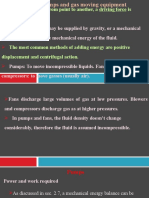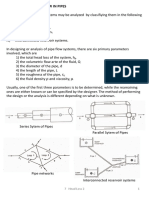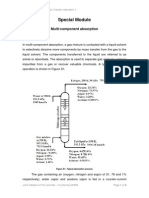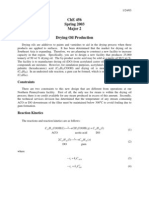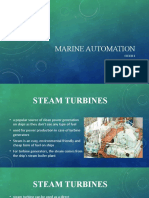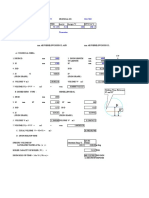ChemCAD Assignment SPR05
ChemCAD Assignment SPR05
Uploaded by
laiping_lumCopyright:
Available Formats
ChemCAD Assignment SPR05
ChemCAD Assignment SPR05
Uploaded by
laiping_lumOriginal Description:
Copyright
Available Formats
Share this document
Did you find this document useful?
Is this content inappropriate?
Copyright:
Available Formats
ChemCAD Assignment SPR05
ChemCAD Assignment SPR05
Uploaded by
laiping_lumCopyright:
Available Formats
Individual ChemCAD/ASPEN Assignment ChBE 431 Using ChemCAD and ASPEN, simulate the production of 25,000 metric tons/yr
(produced 24/7 335/yr) of 99 mole% of drying oil (C14H28) from the decomposition of acetylated castor oil (C15H31COOH): C15H31COOH ACO C14H28 + CH3COOH DO acetic acid (1)
The kinetics are described as follows: -rACO = (ko exp(-Ea/RT))*CACO rxn 1 Ei kcal/kmol 40,000 ko,i kmol/m3s 1 1013 (2)
Start your PFD with pure acetylated castor oil at 375C and 220kPa. You must use a kinetic reactor operating at 220 kPa and 375C with a pressure drop of 0.2 bar. The conversion of ACO in this reactor must be 85%. The reactor effluent should be cooled with one heat exchanger (the simplest one the simulator has) and then most likely sent to a flash (can be at any reasonable pressure or temp. Note: it is OK if the flash includes some DO and ACO in the overhead, but try to keep this to a minimum.) The bottoms stream from the flash should be sent to a separation unit(s) (can be any reasonable pressure) where DO will eventually be recovered. Try your best to purify and recycle the ACO back to the reactor. Try to achieve the highest purity of DO possible while not wasting ACO and/or contaminating the acetic acid stream. Label all units as 500 series. In a 5-10 single spaced page (not including tables, equations, and figures) report, write a process description for a PFD (see the example on page 113 of your textbook) based on one of your diagrams (you can choose to describe the ASPEN PFD or the ChemCAD PFD.) Provide an equipment summary table and a flow summary table for both (follow the examples provided on pages 942-945 of your textbook.) In the equipment summary table, be sure to explicitly mention important parameters such as reactor volume, distillation column length and diameter, number of trays, etc. Discuss and justify any decisions you had to make in preparing your PFD. I. Introduction: Discuss project goals Provide background information such as the reaction, the kinetics, etc. Discuss any constraints for the process.
II. PFD, Flow Stream Table, and Equipment Summary for both ASPEN and ChemCAD III. Discussion : Provide a process description for a PFD Discuss your choice of thermodynamic model Discuss why each design is the way it is. Explain why this is the most efficient, best design for the process under these constraints. Justify use of high temperature/pressure, large volumes, etc. if necessary. If the ASPEN and ChemCAD processes are different, explain why.
In addition, imagine we now built the plant according to your specifications. Discuss how the following scenarios would change the process, (assuming the sizes of the equipment have to remain the same): a. b. c. d. If the DO demand drops by 20% If water were an additional input to the system along with the ACO feed A new catalyst is used which changed the activation energy to 50,000 kcal/kmol The reactor is unable to maintain pressure and must run at 1 bar
(You do not have to simulate these scenarios with ChemCAD or ASPEN, simply hypothesize and describe how the process would change.) IV. Conclusions Summary of new information youve discovered by simulating this process with both packages.
How this will be graded: 15% - Reactor Design/Volume 35% - Design of separation units + recycle 15% - Justification of Design decisions 12% - Discussion of Scenarios 5% - Process Description 3% - Choice of model 15% - Readability, grammar, effective communication of ideas and concepts, organization, layout, appearance
To determine the size of a distillation column in ChemCAD 1. single click on tower in run simulation mode 2. under sizing, click vessel 3. lots of parameters 4. make sure vertical, click OK 5. new window, more parameters, just click OK 6. word pad with relevant data including length and L/D values will pop up.
You might also like
- Shift Reactor CalculationsDocument2 pagesShift Reactor Calculationsankitsamria0% (1)
- ME 346 Lab Final ExamDocument9 pagesME 346 Lab Final ExamSaad RasheedNo ratings yet
- 423 Problem Set 1Document2 pages423 Problem Set 1keithcrosley0% (1)
- Modeling and Simulation of CSTR For Manufacture of Propylene GlycolDocument6 pagesModeling and Simulation of CSTR For Manufacture of Propylene Glycolantoojacome100% (1)
- CF BraunDocument4 pagesCF BraunTito EcheverriaNo ratings yet
- Assignment 2 SolutionDocument3 pagesAssignment 2 SolutionJacob Johnston100% (1)
- Acetone BDocument9 pagesAcetone BIrdani IdrisNo ratings yet
- H84ACM Coursework GuidelinesDocument6 pagesH84ACM Coursework GuidelinesYeeXuan TenNo ratings yet
- Pump and Gas Moving EquipmentDocument13 pagesPump and Gas Moving EquipmentM.Ghulam Al-AyubiNo ratings yet
- Analogies of Transport PropertiesDocument3 pagesAnalogies of Transport PropertiesAB Devilier100% (1)
- Reactor Design - DmeDocument5 pagesReactor Design - DmeKayNo ratings yet
- Capital Cost EstimationDocument29 pagesCapital Cost EstimationZati TarhiziNo ratings yet
- ME303 7 Head Loss 2 BranchedDocument39 pagesME303 7 Head Loss 2 Branchedtoshugo100% (1)
- UNIT II: Fuels: SyllabusDocument26 pagesUNIT II: Fuels: SyllabusMAYUR BHOSALE100% (1)
- Steam Nozzle ProblemsDocument5 pagesSteam Nozzle ProblemsGopinath Narayanan100% (1)
- Experiment 6 Performance of Centrifugal Compressor: A. ObjectiveDocument6 pagesExperiment 6 Performance of Centrifugal Compressor: A. ObjectiveSurjit DuttaNo ratings yet
- Vessel VolumesDocument71 pagesVessel VolumesAnonymous a4Jwz14W100% (1)
- EES Code For Transient SystemDocument2 pagesEES Code For Transient SystemDhrupad Parikh0% (1)
- Special ModuleDocument6 pagesSpecial ModuleMrinal BiswasNo ratings yet
- CH 17Document43 pagesCH 17ዝምታ ውስጤ ነውNo ratings yet
- NTPC Anta Training ReportDocument33 pagesNTPC Anta Training Reportpradeep meenaNo ratings yet
- The Urea Manufacturing ProcessDocument5 pagesThe Urea Manufacturing ProcessJhonny Huanca ChampiriNo ratings yet
- HW 5Document8 pagesHW 5Anonymous AjrDxGNo ratings yet
- 2014 3P4 Midterm 1 SolutionsDocument9 pages2014 3P4 Midterm 1 SolutionsIsibor CaptainNo ratings yet
- Tabela Heat TransferDocument27 pagesTabela Heat Transfersaturno37No ratings yet
- ThermodynamicsDocument15 pagesThermodynamicsJimmy OrajayNo ratings yet
- Assignment EIADocument7 pagesAssignment EIAShubham ChoudharyNo ratings yet
- Envision WareDocument36 pagesEnvision WareBhanu Singh SainiNo ratings yet
- Sodium Hydroxide Production From Seawater Desalination Brine: Process Design and Energy EfficiencyDocument38 pagesSodium Hydroxide Production From Seawater Desalination Brine: Process Design and Energy EfficiencyjuanNo ratings yet
- Solar Space Heating and CoolingDocument14 pagesSolar Space Heating and CoolingGiri Shankar GSBSNo ratings yet
- Process Dynamics & Control: Muhammad Rashed JavedDocument33 pagesProcess Dynamics & Control: Muhammad Rashed JavedTalha ImtiazNo ratings yet
- Assignment 1a (Monsoon 2019) - 2Document9 pagesAssignment 1a (Monsoon 2019) - 2pochireddy revathiNo ratings yet
- ICE Handout 2 PDFDocument14 pagesICE Handout 2 PDFFaizan AhmedNo ratings yet
- Day 2 - Flange Design 14.3Document34 pagesDay 2 - Flange Design 14.3Anustup MaityNo ratings yet
- Steam Power Plant 1Document17 pagesSteam Power Plant 1MohammedNo ratings yet
- Equilibrium ChartsDocument29 pagesEquilibrium ChartsanikfaisalNo ratings yet
- 5.18 Materials Science 9thDocument1 page5.18 Materials Science 9thJemuelNo ratings yet
- Appendix F - SteamTableDocument76 pagesAppendix F - SteamTableGregory WhiteNo ratings yet
- Numerical For Practice MidtermDocument3 pagesNumerical For Practice MidtermSiddhant SinhaNo ratings yet
- Solution Thermodynamics 2020Document49 pagesSolution Thermodynamics 2020Esha ChohanNo ratings yet
- Design and Optimization of A Throttle Body Assembly by CFD AnalysisDocument11 pagesDesign and Optimization of A Throttle Body Assembly by CFD Analysisbob loblawNo ratings yet
- Separations and Reaction Engineering Design Project Production of AmmoniaDocument10 pagesSeparations and Reaction Engineering Design Project Production of AmmoniaRyan WahyudiNo ratings yet
- Ethanol DDocument13 pagesEthanol DAndrea LeonNo ratings yet
- Ammonia D PDFDocument10 pagesAmmonia D PDFrkm_rkmNo ratings yet
- Ethylene Plus Benzene Design Project Reference (Partial Only)Document11 pagesEthylene Plus Benzene Design Project Reference (Partial Only)YueZhen ChuaNo ratings yet
- Che 456 Spring 2003 Major 2 Drying Oil Production: ConstraintsDocument7 pagesChe 456 Spring 2003 Major 2 Drying Oil Production: ConstraintstonbaldinNo ratings yet
- Allyl3 LECHO FLUIDocument9 pagesAllyl3 LECHO FLUIJoha BetancurNo ratings yet
- University of Cape Town Department of CHDocument6 pagesUniversity of Cape Town Department of CHmehul10941No ratings yet
- Acetone ProductionDocument8 pagesAcetone ProductionZahraa GhanemNo ratings yet
- Obtencion de AcetonaDocument7 pagesObtencion de AcetonaLiz Laureano RodriguezNo ratings yet
- Separations and Reaction Engineering Design Project Production of MTBEDocument10 pagesSeparations and Reaction Engineering Design Project Production of MTBEParaZzzitNo ratings yet
- CHEMCAD 5 1 3 Example Book PrintableDocument36 pagesCHEMCAD 5 1 3 Example Book PrintableOliver RomeroNo ratings yet
- Allyl KlorürDocument8 pagesAllyl KlorürYiğit ErkulNo ratings yet
- Tutorial 5Document6 pagesTutorial 5Hafiz Mudaser AhmadNo ratings yet
- Ammonia B PDFDocument9 pagesAmmonia B PDFmehrdad_k_rNo ratings yet
- CHNG 2006 Midterm1 (2007) RevisedDocument7 pagesCHNG 2006 Midterm1 (2007) RevisedSamet YildizNo ratings yet
- Separations and Reactors Design Project Production of Allyl ChlorideDocument8 pagesSeparations and Reactors Design Project Production of Allyl ChlorideAdelina SimionNo ratings yet
- Aspen Homework #1, Due Tuesday, November 1st, 2016Document2 pagesAspen Homework #1, Due Tuesday, November 1st, 2016Michael Taylor WarrenNo ratings yet
- Che 456 Spring 2007 Major 2 Production of Formalin: BackgroundDocument6 pagesChe 456 Spring 2007 Major 2 Production of Formalin: BackgroundJosselyn VilcaNo ratings yet
- Don't Gamble With Physical Properties For SimulationsDocument12 pagesDon't Gamble With Physical Properties For Simulationslaiping_lum100% (1)
- 04 - Absorbers PDFDocument7 pages04 - Absorbers PDFlaiping_lumNo ratings yet
- Define Process Synthesis & Explain Its SignificanceDocument36 pagesDefine Process Synthesis & Explain Its Significancelaiping_lumNo ratings yet
- TopsoeDocument5 pagesTopsoelaiping_lumNo ratings yet
- Previous Project NotesDocument12 pagesPrevious Project Noteslaiping_lumNo ratings yet
- Remove Password From A Protected Excel Worksheet - The Most Authoritative Technology BlogDocument8 pagesRemove Password From A Protected Excel Worksheet - The Most Authoritative Technology Bloglaiping_lumNo ratings yet
- Remove Password From A Protected Excel Worksheet - The Most Authoritative Technology BlogDocument8 pagesRemove Password From A Protected Excel Worksheet - The Most Authoritative Technology Bloglaiping_lumNo ratings yet
- Many-Body TheoryDocument93 pagesMany-Body TheoryDavid ParfittNo ratings yet
- Week 3 - Automation of Steam TurbinesDocument18 pagesWeek 3 - Automation of Steam TurbinesJustin CaliguiaNo ratings yet
- Driesse 2020 From IEC 61853 Power Measurements To PV System SimulationsDocument47 pagesDriesse 2020 From IEC 61853 Power Measurements To PV System SimulationsJeanNo ratings yet
- Integrated MBA (IMBA) Programme - V Semester SyllabusDocument9 pagesIntegrated MBA (IMBA) Programme - V Semester SyllabusRishabh KumarNo ratings yet
- Test 1Document6 pagesTest 1AKASH PALNo ratings yet
- ERF 2016 37 H160 Thermoplastic RotorhubDocument9 pagesERF 2016 37 H160 Thermoplastic RotorhubHelimanualNo ratings yet
- Tarija Bolivia Climate Part 2 V5bDocument29 pagesTarija Bolivia Climate Part 2 V5bMariPGNo ratings yet
- Comparison of The Dental and Skeletal Changes Associated With Maxillary Molar Distalization by Four Different Appliances: An in Vivo StudyDocument8 pagesComparison of The Dental and Skeletal Changes Associated With Maxillary Molar Distalization by Four Different Appliances: An in Vivo StudyrohitNo ratings yet
- IB Chemistry IA Energetics PDFDocument10 pagesIB Chemistry IA Energetics PDFYoshua YanottamaNo ratings yet
- Saudi Pharmaceutical JournalDocument10 pagesSaudi Pharmaceutical JournalDiky ArdianNo ratings yet
- Acoustic Measurement and Prediction of Solid Rockets in Static Firing TestsDocument13 pagesAcoustic Measurement and Prediction of Solid Rockets in Static Firing TestsSherelyn RoblesNo ratings yet
- Winols Guide 130pd To 150pdDocument13 pagesWinols Guide 130pd To 150pdtzskojevacNo ratings yet
- Diodes and ApplicationsDocument23 pagesDiodes and Applicationsjovinchungath777No ratings yet
- Cambridge International AS & A Level: Chemistry 9701/34Document12 pagesCambridge International AS & A Level: Chemistry 9701/34LongNo ratings yet
- 4.6 Full System Leak Detection PhilosophyDocument6 pages4.6 Full System Leak Detection PhilosophyPaidar Engineering and Energy Development Co.No ratings yet
- Ict 11 Activity 3Document4 pagesIct 11 Activity 3MAYNo ratings yet
- Module 1Document23 pagesModule 1Edbert TulipasNo ratings yet
- Q2 - WS - Mathematics 4 - Lesson 8 - Week 8Document12 pagesQ2 - WS - Mathematics 4 - Lesson 8 - Week 8Amelia Mayor ColeNo ratings yet
- Ø Ù Ø Ù Ù Ø© Ù Ø Ø Ù Ù Homers Odyssey Ù Ø Ù Ù Ø Ù Ø© Ù Ø Ø Ù Ù Ù Ù Ù Ù Ø Ø Ø Ø Ù Ø Ø Ø Ø®Ø Ø Ù Ø Ù Ù Ø Ø Ø Ø 2Document422 pagesØ Ù Ø Ù Ù Ø© Ù Ø Ø Ù Ù Homers Odyssey Ù Ø Ù Ù Ø Ù Ø© Ù Ø Ø Ù Ù Ù Ù Ù Ù Ø Ø Ø Ø Ù Ø Ø Ø Ø®Ø Ø Ù Ø Ù Ù Ø Ø Ø Ø 2Kosmas FiliousisNo ratings yet
- Post Assessment - Design Patterns PDFDocument3 pagesPost Assessment - Design Patterns PDFAmit SharmaNo ratings yet
- Exp 1 State of Flow AaaDocument9 pagesExp 1 State of Flow AaaKIM TAEHYUNGNo ratings yet
- SC Series Vmware Vsphere Best Practices - en UsDocument78 pagesSC Series Vmware Vsphere Best Practices - en UsibmmasterNo ratings yet
- Construction of 0-3000 Watts Digital WattmeterDocument30 pagesConstruction of 0-3000 Watts Digital WattmeterVincent KorieNo ratings yet
- Deaerator Drum SizingDocument4 pagesDeaerator Drum SizingtauqeerNo ratings yet
- BarChartsInc 2014 ProcessManagement OperationsManagementDocument1 pageBarChartsInc 2014 ProcessManagement OperationsManagementJohn Michael SorianoNo ratings yet
- Developing and Validating Test ItemDocument456 pagesDeveloping and Validating Test ItemIndah Surya Rachmani100% (1)
- UML Diagrams Part 2 PDFDocument10 pagesUML Diagrams Part 2 PDFYasmine2410No ratings yet
- Vol 101Document124 pagesVol 101Abiy MulugetaNo ratings yet
- Database Management Systems (18CS1T02) - End-Term Exam - 2019-2020Document2 pagesDatabase Management Systems (18CS1T02) - End-Term Exam - 2019-2020sahu.tukun003No ratings yet
- Dr. Nicholas Smith: The HornsmithDocument13 pagesDr. Nicholas Smith: The HornsmithYung SangNo ratings yet








